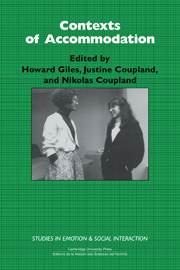Book contents
- Frontmatter
- Contents
- List of contributors
- 1 Accommodation theory: Communication, context, and consequence
- 2 Audience accommodation in the mass media
- 3 Accommodation on trial: Processes of communicative accommodation in courtroom interaction
- 4 Accommodation in medical consultations
- 5 Accommodation and mental disability
- 6 Accommodation in therapy
- 7 Accommodation in native-nonnative interactions: Going beyond the “what” to the “why” in second-language research
- 8 Interethnic accommodation: The role of norms
- 9 Organizational communication and accommodation: Toward some conceptual and empirical links
- Index
7 - Accommodation in native-nonnative interactions: Going beyond the “what” to the “why” in second-language research
Published online by Cambridge University Press: 18 March 2010
- Frontmatter
- Contents
- List of contributors
- 1 Accommodation theory: Communication, context, and consequence
- 2 Audience accommodation in the mass media
- 3 Accommodation on trial: Processes of communicative accommodation in courtroom interaction
- 4 Accommodation in medical consultations
- 5 Accommodation and mental disability
- 6 Accommodation in therapy
- 7 Accommodation in native-nonnative interactions: Going beyond the “what” to the “why” in second-language research
- 8 Interethnic accommodation: The role of norms
- 9 Organizational communication and accommodation: Toward some conceptual and empirical links
- Index
Summary
Introduction
In recent years, an increasing amount of research on second-language acquisition (SLA) has shifted away from studying aspects of the learner's second language (L2) behavior in isolation. The emphasis in the 1970s was on analyses of errors in the learner's language, in support of linguistic theory stating that there are certain universals that govern all SLA. By implication, it was assumed that all learners make the same, or similar, errors (see e.g., Burt and Dulay 1975; Oiler and Richards 1973; Richards 1974; Schumann and Stenson 1975). Although there is still some theoretical support for such a research orientation, a growing number of SLA researchers have begun to study L2 learners as they interact with others, whether it be native speakers (NSs) of the language they are learning or other nonnative speakers (NNSs). The shift toward interactionally situated research can be credited, in large part, to theoretical assertions by Krashen (1981, 1982) that comprehensible input from the L2 learner's interlocutor is crucial for language acquisition to take place. Also influential are claims by Long (1981, 1983, 1985), Hatch (1983), and others that in interactions, it is the negotiations toward meaning that are necessary for L2 development.
The growth in research on NS-NNS interactions clearly represents an important step toward the study of language as communication. However, much of the research is atheoretical, confined to linguistic descriptions of the NNS's or NS's speech. Since NNSs and NSs communicate within a social context that they both influence and are influenced by, it is essential to tie the research to sociolinguistic theory. In so doing, we can go beyond linguistic description to an explanation of how NSs and NNSs communicate.
- Type
- Chapter
- Information
- Contexts of AccommodationDevelopments in Applied Sociolinguistics, pp. 223 - 244Publisher: Cambridge University PressPrint publication year: 1991
- 26
- Cited by



